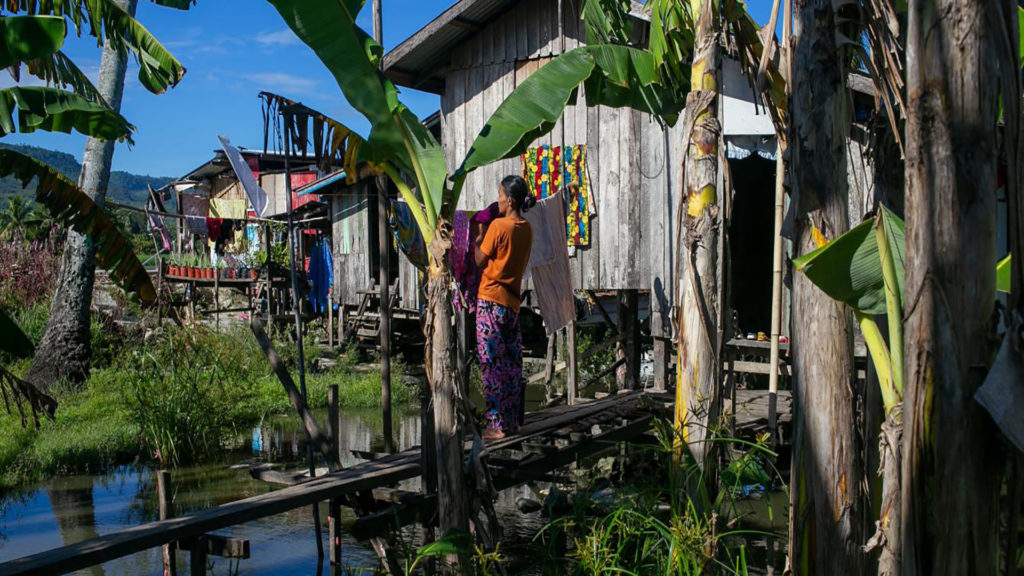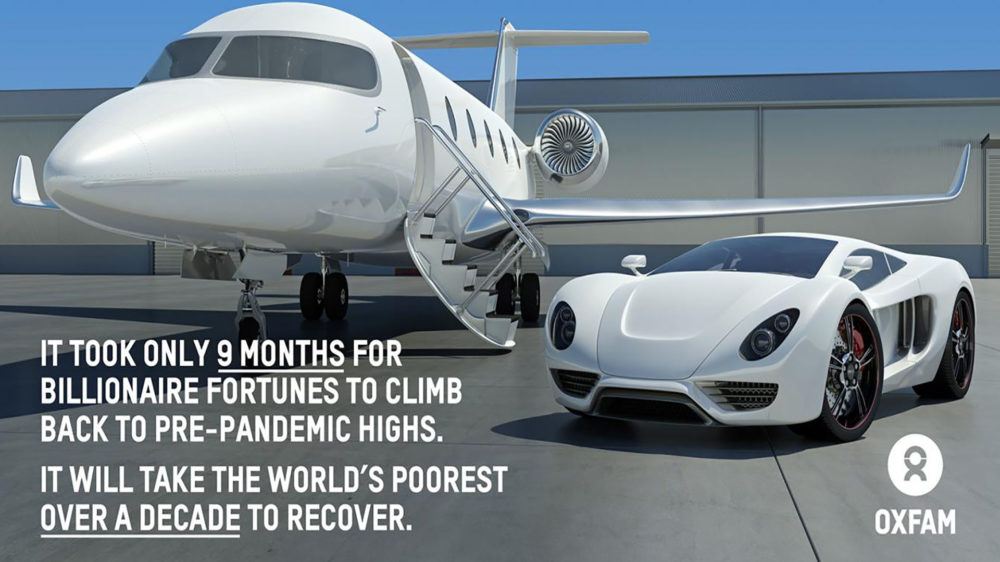
As the cost of essential goods rises faster than it has in decades, billionaires in the food and energy sectors are increasing their fortunes by $1 billion dollars every two days.
For every new billionaire created during the pandemic — one every 30 hours — nearly a million people could be pushed into extreme poverty in 2022 at nearly the same rate, reveals a new Oxfam brief today. “Profiting from Pain” is published as the World Economic Forum — the exclusive get-together of the global elite in Davos — takes place for the first time face-to-face since COVID-19, a period during which billionaires have enjoyed a huge boost to their fortunes.
“Billionaires are arriving in Davos to celebrate an incredible surge in their fortunes. The pandemic and now the steep increases in food and energy prices have, simply put, been a bonanza for them. Meanwhile, decades of progress on extreme poverty are now in reverse and millions of people are facing impossible rises in the cost of simply staying alive,” said Gabriela Bucher, Executive Director of Oxfam International.
The brief shows that 573 people became new billionaires during the pandemic, at the rate of one every 30 hours. We expect this year that 263 million more people will crash into extreme poverty, at a rate of a million people every 33 hours.
Oxfam Pilipinas Country Director Lot Felizco said the impact of the pandemic is already being felt by countries like the Philippines, which recently saw a further increase in self-rated poverty as shown in the latest results of the Social Weather Stations survey.
“It is very alarming to learn from the Oxfam International report that there are those who are profiting from this crisis when so many ordinary people are suffering from poverty and hunger. These are the same people — workers and farmers — who serve as the backbone of our economy,” Felizco said.
Billionaires’ wealth has risen more in the first 24 months of COVID-19 than in 23 years combined. The total wealth of the world’s billionaires is now equivalent to 13.9 percent of global GDP. This is a three-fold increase (up from 4.4 percent) in 2000.
“Billionaires’ fortunes have not increased because they are now smarter or working harder. Workers are working harder, for less pay and in worse conditions. The super-rich have rigged the system with impunity for decades and they are now reaping the benefits. They have seized a shocking amount of the world’s wealth as a result of privatization and monopolies, gutting regulation and workers’ rights while stashing their cash in tax havens — all with the complicity of governments,” said Bucher.
“Meanwhile, millions of others are skipping meals, turning off the heating, falling behind on bills and wondering what they can possibly do next to survive. Across East Africa, one person is likely dying every minute from hunger. This grotesque inequality is breaking the bonds that hold us together as humanity. It is divisive, corrosive and dangerous. This is inequality that literally kills.”
Oxfam’s new research also reveals that corporations in the energy, food and pharmaceutical sectors —where monopolies are especially common— are posting record-high profits, even as wages have barely budged and workers struggle with decades-high prices amid COVID-19. The fortunes of food and energy billionaires have risen by $453 billion in the last two years, equivalent to $1 billion every two days. Five of the largest energy companies (BP, Shell, TotalEnergies, Exxon and Chevron) are together making $2,600 profit every second, and there are now 62 new food billionaires.
Together with just three other companies, the Cargill family controls 70 percent of the global agricultural market. Last year Cargill made the biggest profit in its history ($5 billion in net income) and the company is expected to beat its record profit again in 2022. The Cargill family alone now has 12 billionaires, up from eight before the pandemic.
From Sri Lanka to Sudan, record-high global food prices are sparking social and political upheaval. 60 percent of low-income countries are on the brink of debt distress. While inflation is rising everywhere, price hikes are particularly devastating for low-wage workers whose health and livelihoods were already most vulnerable to COVID-19, particularly women, racialized and marginalized people. People in poorer countries spend more than twice as much of their income on food than those in rich countries.
• Today, 2,668 billionaires — 573 more than in 2020 — own $12.7 trillion, an increase of $3.78 trillion.
• The world’s ten richest men own more wealth than the bottom 40 percent of humanity, 3.1 billion people.
• The richest 20 billionaires are worth more than the entire GDP of Sub-Saharan Africa.
• A worker in the bottom 50 percent would have to work for 112 years to earn what a person in the top 1 percent gets in a single year.
• High informality and overload due to care tasks have kept 4 million women in Latin America and the Caribbean out of the workforce. Half of working women of color in the US earn less than $15 an hour.
The pandemic has created 40 new pharma billionaires. Pharmaceutical corporations like Moderna and Pfizer are making $1,000 profit every second just from their monopoly control of the COVID-19 vaccine, despite its development having been supported by billions of dollars in public investments. They are charging governments up to 24 times more than the potential cost of generic production. 87 percent of people in low-income countries have still not been fully vaccinated.
“The extremely rich and powerful are profiting from pain and suffering. This is unconscionable. Some have grown rich by denying billions of people access to vaccines, others by exploiting rising food and energy prices. They are paying out massive bonuses and dividends while paying as little tax as possible. This rising wealth and rising poverty are two sides of the same coin, proof that our economic system is functioning exactly how the rich and powerful designed it to do,” said Bucher.
“Over two years since the pandemic began, after more than 20 million estimated deaths from COVID-19 and widespread economic destruction, government leaders in Davos face a choice: act as proxies for the billionaire class who plunder their economies, or take bold steps to act in the interests of their great majorities. One common economic sense measure above all will put this to the test: whether governments will finally tax billionaire wealth”.
Oxfam recommends that governments urgently:
• Introduce one-off solidarity taxes on billionaires’ pandemic windfalls to fund support for people facing rising food and energy costs and a fair and sustainable recovery from COVID-19. Argentina adopted a one-off special levy dubbed the ‘millionaire’s tax’ and is now considering introducing a windfall tax on energy profits as well as a tax on undeclared assets held overseas to repay IMF debt. The super-rich have stashed nearly $8 trillion in tax havens.
• End crisis profiteering by introducing a temporary excess profit tax of 90 percent to capture the windfall profits of big corporations across all industries. Oxfam estimated that such a tax on just 32 super-profitable multinational companies could have generated $104 billion in revenue in 2020.
• Introduce permanent wealth taxes to rein in extreme wealth and monopoly power, as well as the outsized carbon emissions of the super-rich. An annual wealth tax on millionaires starting at just 2 percent, and 5 percent on billionaires, could generate $2.52 trillion a year —enough to lift 2.3 billion people out of poverty, make enough vaccines for the world, and deliver universal healthcare and social protection for everyone living in low- and lower middle-income countries.
Notes to editors:
Download “Profiting from Pain” and the methodology document outlining how Oxfam calculated the statistics in the brief.
Oxfam’s calculations are based on the most up-to-date and comprehensive data sources available. Figures on the very richest in society come from the Forbes billionaire list.
All amounts are expressed in US dollars and, where relevant, have been adjusted for inflation using the US consumer price index.
The World Bank defines extreme poverty as living on less than $1.90 per day.
One person is likely dying of hunger every 48 seconds in drought-ravaged Ethiopia, Kenya and Somalia, according to estimates by Oxfam and Save the Children.
Half of working women of color in the US earn less than $15 an hour. This not enough to cover cost-of-living for most households, and leaves millions of families in the US below the poverty line.
According to Gabriel Zucman, the super-rich have stashed nearly $8 trillion in tax havens.
